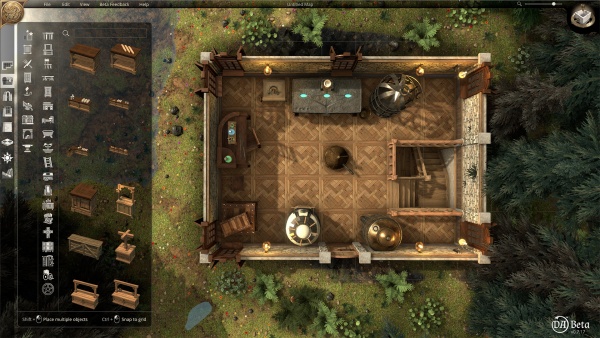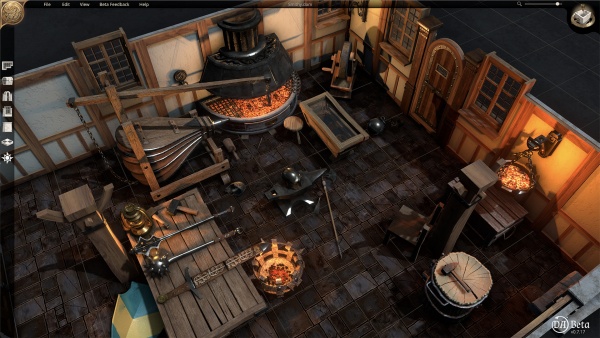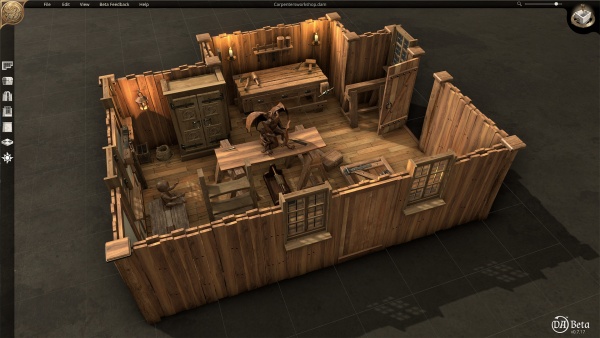AI-generated content is a rather controversial topic and for good reason. We all had a laugh during the first iteration of AI images, where we could imagine Bernie Sanders in Mortal Kombat was a good time and harmless enough. But now with AI art on the rise, many have serious concerns for the future of art and culture. Now I personally believe that AI-generated content can be a benefit, so long as it’s in moderation, provides help to artists and designers and above all, doesn’t mean people lose their jobs and passion for creating.
Thus I was really keen to check out Dungeon Alchemist, as I saw it as a great tool for a number of ventures and reasons, both professional and personal. But is this user-generated content tool a must for any D&D games master, game designer and many more?
What is Dungeon Alchemist?
Dungeon Alchemist is an “AI-powered” game mapmaker with a focus on fantasy and D&D thematic elements. It’s an incredible bit of software that allows you to make high-quality and very detailed maps with ease and in a speedy manner of time. You pick a theme, draw the layout of the location you want to be created, and the Dungeon Alchemist does the rest! Whether you want a map set within a graveyard, an old spooky mansion, a creepy decaying dungeon or another classic fantasy environment, you just start drawing and everything is laid out before you.
Best of all, Dungeon Alchemist enables designers and dungeon masters to print their high-quality maps, share them, and use in your favourite Virtual Tabletop Application. So, you can make several compelling maps for your D&D night in a matter of minutes or spend longer and fully customising the world with a vast number of objects, décor and alterations to the world including death traps and secret passages.
Reminds me of those old-level editors (Timesplitters 3, Tenchu 2)
I’m a massive fan of making games (insert meme of Willem Defoe saying “I’m something of a games designer myself”) ever since a young age and spend countless hours making maps and levels as an inspiring game designer.
Dungeon Alchemist has that vibe for me too, and while it doesn’t feature implementing logic, set pieces and various interactive mechanics, it does indeed allow you to be immensely creative in world design. From the get-go, you can create whatever your heart desires, and wherever you wish to adventure. Whether that be a small dungeon or a fully fleshed-out town consisting of multiple areas, and buildings. You can put together a lot of locations in a matter of minutes, with as much or little detail, to suit the needs of your games night or design tasks at hand.
And the core positives for Dungeon Alchemist are quite simply, its flexibility, ease of control and the vast amount of thematic elements and customisation at hand to make whatever you please.
Starting off you can adjust the scale of the world, to fit the needs of a small outing or a grand adventure, with plenty of options that suit your printing needs, be it, you wish to print a poster-size map of a beautiful world to explore.
You can alter the terrain, and landscape, to take yourself and your friends through lush grasslands, dense jungles, scorching deserts, marshlands, and badlands. With these settings in mind, you can add further inclusions to make the world even more interesting and change the landscape further to dynamic alter your town, castle, palace or gingerbread house filled with flesh-eating goblins (yep, there is currently a gingerbread décor). You can also change the time of day, which has effects you can see on the map, covering dawn to dusk and night-time.
So of course, you could have a map with a gingerbread house belonging to a deranged alchemist set on a lonesome island in the middle of a hot summer’s day. Or create crumbling ruins in the middle of a mash land that may or may not be haunted bathed in the red dusk of dawn. Or how about creating a seemingly quiet town that’s a little too quiet, and you must investigate where everyone has gone in the middle of the night.
There is plenty of room to easily set up the ideal location and enough content to make these maps go further.
Making a world with ease
Dungeon Alchemist is quite an easy software to get to grips with and there are plenty of helpful options and guides if you need assistance. Starting up and making the landscape takes little work at all, but there are those options to make the world a little more interesting, depending on the scenario you wish you make.
But the true magic and the main selling point of Dungeon Alchemist is seeing the vast number of hubs, rooms and key areas come to life, filled with all manner of objects within a manner of seconds. Again, doing all this is incredibly easy and within a manner of minutes, you could make a whole town, castle or dungeon to explore. Just drag your cursor over a set number of tiles, highlighting an area which will become that desired room and click confirm to make it happen. In a blink of an eye, you’ll have your town square, bakery, torture chamber or cosmic temple hall with a portal to another dimension.
That’s really about it for the functionality in creating, but of course, you can delete and alter existing rooms if you so wish, which again is quite easy to accomplish. You can delete half of a room you’ve already built, and the AI will do the rest, altering the remains to fit the new size and landscape.
But of course, if you so wish to make tweaks and inclusions of your own, you can do so indeed, as Dungeon Alchemist has an impressive number of assets, including other exterior and interior to make the world truly your own. You can freely place doors, windows, chests, statues, traps, stairs, lights and so much more as you please, to make the world fit the adventure you wish you create.
It really is quite impressive to see all the objects you can place in the world, including tokens for events and enemies if you so wish. There is wholly enough to make a vast number of compelling locations, that all differ from one another. And editing, altering, cutting and modifying your world can be done with ease, as the UI and controls are straightforward and easy to use. I never found myself lost while diving into making maps, and even going so advanced with the small details never brought about any blockers or moments I felt I couldn’t accomplish the look and feel of the world intended.
In general, there is a vast variety of textures, floor tiles, objects and décor to flesh out the world in a number of impressively creative ways. I can see this only getting better as Dungeon Alchemist adds in more new objects via updates, making the world design even more varied, and allowing for an expansion in creativity. I can see there being add-on content for more themes and objects, which would be super nice, especially if all or most are free to all. But for the main package, there is so much to play around with.
Dungeon Alchemist also presents itself and achieves at being an immensely comfortable software to grasp and provides an excellent level of efficiency at most times for creating maps quickly. Whether you wish you make something quickly or spend time making the world truly your own.
AI is not fully there just yet
Like a lot of AI-generated content, the outcome can indeed be hit or miss, and usually lean on repetition. Dungeon Alchemist is quite powerful and left alone can produce some awesome worlds, yet it can have plenty of moments which are quite lacking in substance and intelligence.
It’s clear that Dungeon Alchemist has trouble with rooms which are too small or too big. You do indeed have to keep in mind that certain rooms should be smaller or larger than what you might plan. For example, a tavern bedroom is nicely put together in four squares, you can go to 8 or 10 even, but above that, there might be some odd behaviours. Such as a bedroom of 8 tiles will have two single beds side by side, then a room 10 or 12 tiles will only have one single bed, and a chest in the corner. It is indeed an RNG thing behind the magic, and at times, it can be a little off.
And for example, you could make two 5 x 5 bedrooms and one could have a single bed in the corner and another will have 7 single beds in the most perplexing positions ever.
At this time there is no way to adjust the “intensity” of the items placed, as it can be either just right, or either oddly empty or overly cluttered. A slider for object numbers would be nice, but thankfully you can just delete a room entirely and start again, or edit the items in the room, place more and delete some rather easily.
Another area which could see improvement, or be a nice addition is to have multiple floors/layers of a map. At the time of this preview, there is only one “floor” and in theory, you can make multiple maps which show different levels of various buildings. But linking these up, and making sure the measures and layouts are correct can be a pain. If there is a layers option, like something you see in Photoshop, where you can have upper and lower levels, to make multiple-level taverns, mansions or dungeons which go deeper than that of the pit in the original Diablo, this could be a massive game changer for the software. But also allow much more flexibility and creativity for advanced dungeon masters who wish you make more complex worlds. Or to the avid level designer who wishes to make a dense and multi-layered fantasy level, such as a fully fleshed-out town something akin to a city in Baldur’s Gate.
I will also say that the top-down view can also make certain items such as doors look odd, and hard to tell apart from walls in a printed format. You can miss all the lovely details on some of these beautifully crafted world objects and scenes in the 2D view, but the 3D looks amazing! Especially with some of the dynamic objects, such as The Eye of Jana, which is a giant, cosmic horror eye that moves around. Really cool.
But these are things which indeed can be improved with updates and hopefully will be.
Overall?Dungeon Alchemist I feel is the answer to my burning question on how AI-generated content could be, as a means of aiding our creativity, without taking away the importance of skill and the human eye. Indeed Dungeon Alchemist is a phenomenally detailed tool, that’s quick and easy to pick up while offering a level of creative freedom for those who wish to utilise the software further than a quick assembly of cool-looking rooms. But Dungeon Alchemist also shows the flaws of AI-generated content, where if left alone it can produce great art, but at most times just copies and pastes, or leaves gaping holes because, at the end of the day, it’s working of algorithms and logic which might not understand a bedroom can’t be two tiles big.
Still, this is a good thing to have human input, and truly this is software for those with even a slight creative edge. For those who want a super easy map-making tool that does everything at a click of a button, it’s not 100% there (and I feel that’s a good thing). But for the dungeon masters, and game designers looking for a great tool to aid their creative flare and map-making skills, then put down the pen and paper and check out this wonderful bit of software!
Dungeon Alchemist is still in early access, so more updates and further previews will be on the way, right up to its official launch.
++ Lots of content to play with
++ Very easy to learn and master
++ Allows for both quick map-making and more detailed, environments tailored by you
+ Highly customisable and has potential for lots more content
-- Printing in 2D can resort some objects and scenery to look flat and obscured
- AI can at times make some oddly laid out and empty rooms (all depending on room type and size).
- Could allow for multiple levels/floors
The publisher provided a Steam review key of Dungeon Alchemist for this preview.




